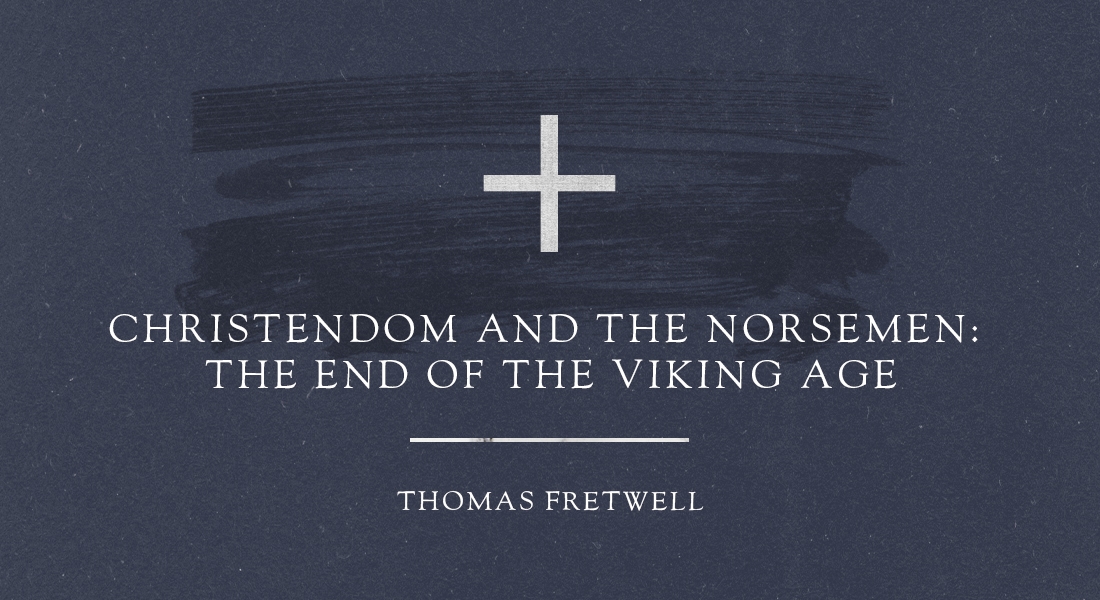
The Age of the Christian Vikings
The ‘conversion’ of the Vikings was not simple. Undoubtedly there were many different roads that led to the eventual cultural dominance of Christianity in formerly Pagan territories. The process was gradual, as Viking settlers assimilated into the larger culture they now inhabited, Christianity was gradually embraced by many of them. There was also active missionary work amongst the Vikings that involved monks travelling to Scandinavia on many occasions.
Evidence of this transitional period is found throughout England. On the Isle of Man there is an artistic depiction on what is known as ‘Thorwald’s Cross’, which has carvings illustrating the Norse god Odin being eaten by the wolf Fenrir on the Day of Ragnarok1 on one side, the other side is filled with Christian imagery, a figure holding a Cross, a fish, and a gospel book trampling on a defeated serpent. Another cross, ‘Sigurd’s Cross’ depicts scenes from the Volsunga Saga which tells the legend of Sigurd killing the dragon Fafnir who is protecting the treasure of Loki the trickster. The famous ‘Gosforth Cross’ stands in the church yard at St Mary’s Church, Gosforth, Cumbria. It stands fifteen feet high and dates to the early 10th century and is decorated with the popular Viking artform known as Gaut’s interlace. It features a crucifixion scene, a Valkyrie and also Thor fishing for Jormungand the Midgard Serpent.2 Even the famous York Minster features stone slabs decorated with typical Viking artwork probably representing the graves of the first Viking Christians of York.
Cleary as the Vikings settled and assimilated into a Christian country, they adopted many aspects of the new religion that ultimately replaced their Norse mythology over time. This was often accelerated when the Viking Kings converted to Christianity whilst abroad and then set about converting their home countries. As early as 940 there was an Archbishop at Canterbury named Oda, he was the son of a pagan Viking settler who had converted.
Denmark
When the King of Denmark Harald Bluetooth converted to the Christianity in 963, he brought his new faith home with him and set about to convert his homeland. Such conversions were often more politically motivated than anything else, yet such openness allowed the propagation of the faith to grow at the grass roots level with the setting up of Churches and the arrival of missionaries. King Harald was responsible for promoting Christianity in Denmark. He built a wooden Church at the Royal Necropolis in Jelling and erected a rune stone in front of the church that features famous imagery of Christ in a crucifixion position wrapped by vines. The inscription on the rune stone reads:
“King Harald had this monument made
in memory of his father Gorm and his
mother Thyri: this was the Harald who
won for himself ll Denmark and
Norway, and made the Danes Christians.”3
Whilst it is true that Harald was the first King to make Christianity the official religion in Denmark, itself a huge feat considering the pagan roots of the Vikings, Christianity had reached Denmark before him. Just before the Viking age in the 8th Century a missionary called Willibrord came to Denmark. In 831 St Ansgar founded the Bishopric in Hamburg which served as a base for missionary activity in Scandinavia. He gained permission to build perhaps the first Church on Scandinavian soil in the Swedish town of Birka.4 So while Christianity was known in Denmark before Harald, to be fully accepted in a Viking society it really needed the support of the ruling class, so in many ways Harald’s conversion would have had a massive impact on the acceptance of Christianity by the Danes.
Norway
The conversion of Norway is mainly attributed to the role of the ‘missionary Kings’, chiefly Olaf Tryggvason and Olaf Haraldson. King Harald Finehair united Norway in 872. He was succeeded by his son Erik Bloodaxe, who was killed in the Viking Kingdom of York, England. He was then replaced by his half-brother Hakon the Good (named this way due to the Christian influence from growing up in the courts of King Athelstan of England). This Christian influence meant that Hakon spent time trying to convert Norway in the 10th century but ultimately gave up in the face of pagan resistance. There is also evidence of missionary activity from England and Germany.5
King Olaf Tryggvason (995-c.1000) raided Folkestone, England in 991. Then it seems that in the year 994 he converted to Christianity and was confirmed at Andover (Hampshire) under the sponsor of King Ethelred II of England. Upon his return to Norway he set about promoting his new faith. It is believed that the king recruited English missionaries to accompany him back to Norway. There are a couple of references to Olaf’s bishop known as Sigfrid who may originally have been a monk at Glastonbury. In the year 1015 Another Christian King emerged, King Olaf II Haraldson (who would later become the patron saint of Norway), and was also baptised whilst abroad. Conversion rapidly spread under his rule in the 1020’s with the assistance of missionaries from Normandy, whose Viking roots supplied a needed cultural connection to the Norse people of Norway.
Sweden
Sweden was the last Scandinavian Kingdom to be converted, which meant the literacy and record keeping which accompanied Christianity did not arrive until much later here. Therefore, what we know about Sweden before it became Christian is limited. Pre-Christian Sweden was not a unified nation state in the same way Denmark was. In fact, Southern Sweden was ruled by Denmark for a considerable period. There were two main political groups in Sweden: The Svear (from which the national name of Sweden is derived) whose political and religious life was located at Uppsala. The second group was the Gotar who settled around lake Vattern in the south. Missionary activity begun in Sweden as early as 829 when the German monk Anskar preached in Sweden. Anskar became the first archbishop of Hamburg. He revisited Sweden a little later in 853 this time with the support of the King. A later surge of missionary activity from Hamburg and England occurred in the 10th century. By the year 1000 Christianity had established a following in Sweden and continued to spread for the next century. The conversion of King Olaf Skotkonung helped the population to accept Christianity as that which would eventually replace their traditional Norse mythology.
Cnut the Great – King of England
It may come as a surprise that England was once ruled by a Viking King. The second wave of Viking attacks against Anglo-Saxon England occurred from about 980 to 1016 under the leadership of Cnut the Great of Denmark. This second wave of Viking raids took Anglo-Saxon England by surprise. The Archbishop of York at the time, Wulfstan, preached a famous sermon where he attributed the new Viking invasions to God’s punishment for the sins of England. The Viking onslaught was so severe that in 1013 King Ethelred fled to Normandy for safety. This meant that Svein of Denmark became the King of England, with his teenage son Cnut as this side.6 Svein died suddenly which caused the English to send for Ethelred to return from Normandy and be King again. Cnut returned to Denmark to see his brother take the throne of Denmark succeeding Svein. However, Cnut returned to England in 1015 and fought a number of Battles with Ethelred’s son Edmund. Following one encounter Edmund and Cnut agreed to divide England between them. However, within months of the agreement Edmund died which meant that Cnut the Great became King of all England. This was shortly followed by the death of his brother Harald II so he also became the King of Denmark.
Christian or Pagan
What did this new era of Viking rule entail for the Christian population of England? A lot had happened in the Viking world since the first invasion in the 10th century. Christianity had been spread across Scandinavia and Cnut himself was a third generation Christian. Although, as was often the case, it is very hard to know whether individual salvation had occurred in these men, but whatever the case their openness to Christianity would have allowed the spread of Christianity. We do know that Cnut worked closely with the archbishop of York to promote Christianity and suppress paganism. The law code known as II Cnut outlawed paganism with the following definition:
“if one worships idols, namely if one worships heathen gods and the sun or the moon, fire or floods, wells or stones or any kind of forest trees, or if one practices witchcraft or encompasses death by any means, either by sacrifice or divination. Or takes part in such delusions.”7
He also founded Churches and was keen to associate the Christianity of Denmark with that of England. He honoured the martyrs of the church such as the murdered Archbishop of Canterbury, Aelfheah. All these actions illustrate that this was not the same Viking rule of the pagan past.
The End of the Viking Age
While much more could be said about the Viking diaspora and the impact they had on the world, suffice to say that by the year 1150 the age of the Vikings was essentially over. Skirmishes still happened, and Norse mythology continued to exert a scattered influence but by and large the once pagan countries of Scandinavia had joined the ranks of medieval Christendom.
NOTES:
1 The end of the world scenario in Viking mythology.
2 Viking Archaeology: The Gosforth Cross.
3 Viking Archaeology: Jelling Royal Necropolis.
4 The Viking Age: The Transition to Christianity.
5 Martyn & Hannah Whittock. The Vikings: From Odin to Christ (Oxford: Lion Hudson 2018) pg. 113.
6 Martyn & Hannah Whittock. The Vikings: From Odin to Christ (Oxford: Lion Hudson 2018) pg. 194.
7 R. Ferguson. The Hammer and the Cross (London: Penguin 2010) pg. 341.






